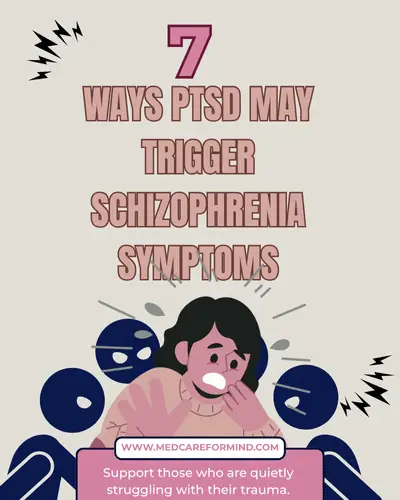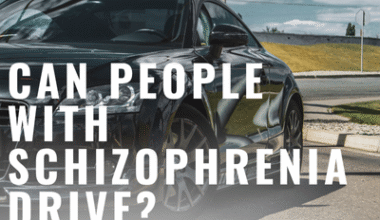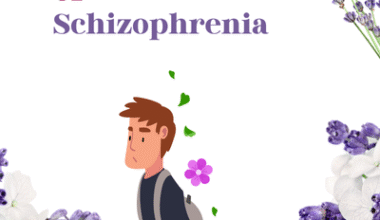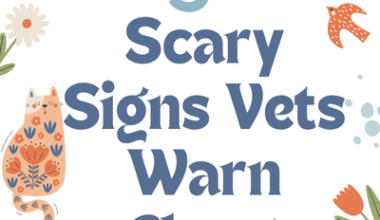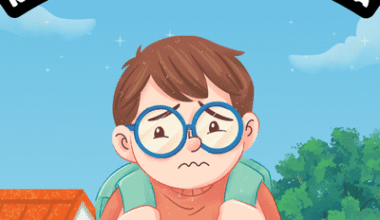Experts suggest that in some cases, trauma can impact the brain so profoundly that it leads to changes associated with schizophrenia. This effect goes far beyond emotional stress, as severe trauma can alter brain function after experiencing extreme or life-threatening events.
In this blog post, we’ll dive into the question Can PTSD cause schizophrenia?, explore their overlapping symptoms, and reveal 7 shocking ways trauma may trigger experiences similar to schizophrenia.
Table of Contents
ToggleUnderstanding PTSD and Schizophrenia Separately
What is PTSD? Causes and Symptoms
PTSD is a mental health condition that develops after experiencing or witnessing life-threatening events such as violence, natural disasters, or severe accidents. Symptoms include flashbacks, nightmares, intense fear, hypervigilance, and emotional numbness. It can last for months or years, interfering with daily life and relationships.
What is Schizophrenia? Causes and Symptoms
Schizophrenia, on the other hand, is a chronic psychiatric disorder affecting how a person thinks, feels, and behaves. Symptoms include hallucinations, delusions, disorganized thinking, social withdrawal, and reduced motivation. The exact cause remains unclear, but it involves a combination of genetic, neurobiological, and environmental factors.
What are the 5 signs of PTSD?
Post-traumatic stress disorder (PTSD) is a mental health condition that can develop after someone experiences or witnesses a terrifying event. While it affects everyone differently, most people with PTSD tend to show a common set of symptoms that interfere with daily life, relationships, and overall mental well-being.

Here are 5 common signs of PTSD:
The five main signs of PTSD include re-experiencing the trauma, where individuals have distressing flashbacks, intrusive memories, or nightmares about what happened. Another sign is avoidance, where a person tries to stay away from people, places, or situations that remind them of the traumatic event. They may also avoid talking or thinking about it altogether, which can interfere with relationships and daily responsibilities.
PTSD also shows up as negative changes in thoughts and mood, such as feeling intense guilt, fear, sadness, or becoming detached from others and losing interest in things they once enjoyed. Hyperarousal is another sign, where someone feels constantly tense, easily startled, irritable, or struggles with sleep and concentration. Lastly, emotional numbness often occurs, making it hard to feel positive emotions or connect with loved ones, leaving them feeling isolated and alone.
What does PTSD do to a person?
PTSD can profoundly impact a person’s thoughts, feelings, and responses to the world. It changes the brain’s stress response, often making someone feel unsafe even when there’s no real threat. Everyday situations, like loud noises, crowds, or certain smells, can trigger intense fear or panic, making normal routines feel overwhelming.
Emotionally, PTSD may cause someone to feel constantly on edge, detached, or numb. Many people struggle with mood swings, guilt, or irritability. Relationships can become strained because it’s hard to explain what they’re feeling or why they suddenly withdraw or overreact. Sleep problems, nightmares, and flashbacks can make it hard to rest or feel at peace.
Over time, PTSD can also impact physical health. Constant stress can lead to headaches, fatigue, digestive issues, or a weakened immune system. It doesn’t just live in the mind—it affects the whole body. Without treatment, PTSD can take a serious toll on mental, emotional, and physical well-being.
What is living with PTSD like?
Living with PTSD often feels like carrying a heavy burden that others cannot see. People may experience intense flashbacks or nightmares, making them relive their trauma over and over, which can be terrifying and exhausting. Even simple things like a sound, smell, or passing comment can trigger overwhelming fear or anxiety, leaving them feeling unsafe in their environment. This leads many to avoid certain places, people, or activities, which can make their world feel small and isolating.
Emotionally, PTSD can bring deep sadness, guilt, or shame, and at times, a sense of numbness where they feel disconnected from themselves and others. They might constantly feel on edge, easily startled by small noises or sudden movements, as if danger is always around the corner. Relationships, work, and daily routines often become difficult to manage, creating a life that feels unpredictable, tiring, and lonely without proper understanding, support, and treatment.
Can PTSD cause schizophrenia?
PTSD and schizophrenia are two different mental health conditions, but there is some connection between them. PTSD does not directly cause schizophrenia, but severe trauma, especially in childhood, can increase the risk of developing psychotic symptoms later in life, particularly in people who are already genetically vulnerable to schizophrenia. Trauma can deeply impact how the brain processes stress and reality, sometimes leading to symptoms that resemble schizophrenia, such as hallucinations or paranoia.
However, it’s important to understand that while PTSD can trigger psychotic-like symptoms, it is not the same as schizophrenia. Schizophrenia is a chronic psychiatric disorder with specific patterns of hallucinations, delusions, and disorganized thinking that go beyond trauma responses. If someone with PTSD is experiencing hallucinations or severe disconnection from reality, they must seek professional help to get an accurate diagnosis and appropriate treatment.
 Why is PTSD so hard to live with?
Why is PTSD so hard to live with?
PTSD is hard to live with because it affects nearly every part of a person’s life. The constant flashbacks, nightmares, and intrusive memories make it feel like the traumatic event is happening over and over again, leaving them in a state of fear and emotional exhaustion. This ongoing distress can make it difficult to focus at work, connect with family and friends, or even feel safe in their own homes. Everyday situations that others find normal can trigger intense anxiety or panic, making life feel unpredictable and overwhelming.
PTSD often brings feelings of guilt, shame, or worthlessness, which can lead to isolation and depression. Many people struggle with feeling emotionally numb or detached from the world around them, making it hard to enjoy life or build meaningful relationships.
Another reason PTSD is so difficult to manage is that its symptoms are often invisible to others. On the outside, a person might seem completely fine, going about their daily life as if nothing is wrong. But inside, they’re fighting an exhausting battle with flashbacks, sleepless nights, and overwhelming anxiety. This hidden struggle can make them feel isolated and misunderstood, as people around them may not realize the depth of their pain or why they react the way they do.
What happens when you yell at someone with PTSD?
Yelling at someone with PTSD can have a deeply negative impact. Because they are already living in a heightened state of fear and alertness, being yelled at can feel threatening and overwhelming. It may trigger their fight, flight, or freeze response, causing intense anxiety, panic attacks, dissociation, or even flashbacks of the trauma they experienced. At that moment, their brain might interpret yelling as danger, not just anger, making them feel unsafe and deeply distressed.
Over time, being yelled at can worsen PTSD symptoms, leading to increased withdrawal, depression, and difficulty trusting others. They may become more guarded, avoidant, or fearful in the relationship, feeling that they cannot express themselves safely. For someone with PTSD, calm, respectful, and supportive communication is crucial to help them feel secure and understood rather than re-traumatized.
PTSD in children
PTSD in children occurs when a child experiences or witnesses a terrifying or life-threatening event, such as abuse, violence, accidents, or natural disasters. Unlike adults, children may not always express their distress through words. Instead, they might show it through changes in behavior, such as becoming unusually clingy, withdrawn, aggressive, or irritable. Some may start bedwetting after being toilet trained, regress to earlier behaviors, or have frequent nightmares and trouble sleeping.
Children with PTSD often re-experience the trauma through repetitive play that reflects aspects of what happened, or they might avoid anything that reminds them of the event. They may seem easily startled, constantly on edge, or experience physical symptoms such as stomachaches or headaches without a clear medical cause. PTSD in children can affect their learning, friendships, and overall emotional development, making early recognition and professional support essential to help them heal and feel safe again.
Does PTSD ever go away?
PTSD does not always go away completely on its own, but with the right treatment and support, many people see a significant improvement in their symptoms. Therapies like Cognitive Behavioral Therapy (CBT), Eye Movement Desensitization and Reprocessing (EMDR), and trauma-focused counseling can help individuals process what happened and reduce the power it holds over their daily lives. For some, medication may also help manage anxiety, depression, or sleep issues related to PTSD.
However, without treatment, PTSD symptoms can last for years and may even get worse over time, especially if new stressors or triggers arise. Even when symptoms improve, certain reminders of the trauma might still cause emotional reactions, but they tend to become more manageable with healing and coping skills. Many people with PTSD go on to live fulfilling lives, especially when they have strong social support and professional help guiding their recovery journey.
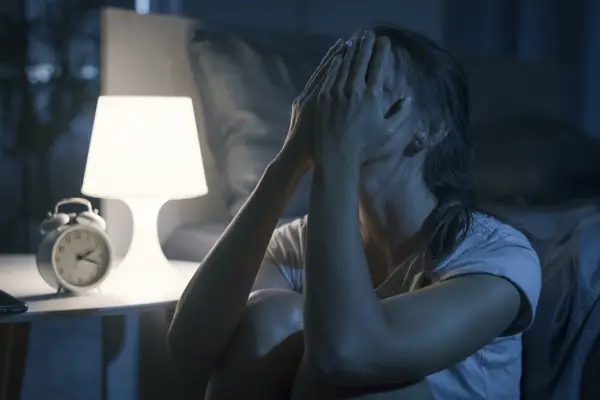 What is the fastest way to calm PTSD?
What is the fastest way to calm PTSD?
There is no instant cure for PTSD, but there are quick ways to calm intense symptoms in the moment. One of the fastest methods is grounding techniques, which help bring you back to the present. They include
-
Deep breathing – Inhale slowly through your nose, hold for a few seconds, and gently exhale through your mouth. Repeat until you feel calmer.
5-4-3-2-1 method – Ground yourself by identifying 5 things you can see, 4 things you can touch, 3 things you can hear, 2 things you can smell, and 1 thing you can taste.
Touch-based grounding – Hold or rub a textured object, like a smooth stone, fabric, or bracelet, to help anchor yourself in the present moment.
Name your surroundings – Say out loud where you are, and what day it is, and remind yourself that you are safe right now.
Can PTSD cause psychosis?
Yes, PTSD can cause psychosis in some cases, though it is not very common. This is known as PTSD with secondary psychotic features (PTSD-SP). People with PTSD-related psychosis may experience hallucinations, such as hearing voices, or delusions, like believing someone is trying to harm them. These psychotic symptoms usually relate to the trauma they experienced and can intensify during flashbacks or severe anxiety.
However, it’s important to note that PTSD itself is not a psychotic disorder. Psychosis linked to PTSD often occurs in individuals who have severe trauma histories, especially if combined with other risk factors like genetic vulnerability or substance abuse.
Treatment usually involves trauma-focused therapy alongside antipsychotic or mood-stabilising medications, depending on the symptoms and individual needs. If someone with PTSD is experiencing psychosis, they must seek professional help immediately for an accurate diagnosis and effective treatment.
Can trauma cause psychosis?
Yes, trauma can cause psychosis in some individuals, especially when the trauma is severe, repeated, or experienced early in life. People exposed to intense stress—such as abuse, violence, or extreme fear—may develop symptoms like hallucinations, delusions, or paranoia. These are signs of trauma-related psychosis, which is different from schizophrenia but can appear similar.
Unlike chronic psychotic disorders, trauma-induced psychosis is often short-term and triggered by specific memories or stressors. The brain, overwhelmed by unresolved trauma, may lose touch with reality as a way to cope. This response is more likely in people with a history of PTSD, anxiety, or dissociation.
What kind of trauma can cause schizophrenia?
Research shows that early and repeated trauma can raise the risk of developing schizophrenia. Traumas that occur in childhood tend to have the strongest impact, especially when they affect brain development and emotional regulation.
Common types of trauma linked to a higher risk include:
-
Physical or sexual abuse
-
Emotional neglect or abandonment
-
Losing a parent or caregiver
-
Exposure to domestic violence
-
Chronic bullying or social isolation
-
Severe accidents or life-threatening events
This is why researchers often ask, Can PTSD cause schizophrenia? PTSD itself doesn’t directly cause schizophrenia, but when trauma is severe and untreated, it may trigger symptoms in people who are already vulnerable.
 Childhood trauma and schizophrenia
Childhood trauma and schizophrenia
Childhood trauma is a significant risk factor for schizophrenia. Experiences such as physical abuse, sexual abuse, emotional neglect, or witnessing domestic violence during childhood can deeply affect brain development and stress response systems. Research shows that people who have gone through severe or repeated trauma as children are more likely to develop psychotic disorders, including schizophrenia, later in life.
Trauma in early years can alter how the brain processes fear, stress, and reality, leading to long-lasting changes in brain chemistry and structure. However, it’s important to understand that childhood trauma alone does not directly cause schizophrenia.
The disorder usually develops due to a combination of genetic vulnerability, brain chemistry, and environmental factors like trauma. Not everyone who experiences childhood trauma will develop schizophrenia, but it does increase the risk, especially if they have a family history or other biological factors that predispose them to mental health disorders.
What is the link between trauma and schizophrenia?
Trauma, especially in childhood, can affect how the brain develops and responds to stress. Over time, this can lead to changes in thinking, emotions, and behavior—some of which may look a lot like schizophrenia.
While trauma alone doesn’t directly cause schizophrenia, it can increase the risk in people who are already vulnerable. For some, the effects of trauma build up and eventually trigger symptoms like paranoia, emotional withdrawal, or even hallucinations.
How else is schizophrenia triggered?
Schizophrenia can be triggered by a combination of factors, not just trauma. Genetics plays a major role; having a family history of schizophrenia or other psychotic disorders significantly increases the risk. However, genetics alone are not enough; environmental factors often act as triggers.
Other common triggers include substance abuse, particularly the use of drugs like cannabis, LSD, or amphetamines, which can induce psychosis in vulnerable individuals. Stressful life events, such as losing a loved one, major life changes, or severe stress at work or school, can also trigger symptoms.
Brain chemistry imbalances, especially involving dopamine and glutamate, and abnormalities in brain structure or development can contribute. Often, it is the combination of these biological, psychological, and environmental factors that leads to the onset of schizophrenia symptoms.
Can trauma cause other types of mental illness?
Yes, trauma can lead to a wide range of mental health conditions, not just schizophrenia. People who’ve been through abuse, loss, violence, or neglect often struggle with depression, anxiety, PTSD, dissociation, or even personality disorders later in life.
The brain’s response to trauma can disrupt emotional regulation, memory, and how it handles stress. Over time, this can show up as panic attacks, mood swings, or emotional numbness. Some people may turn to substances or self-harming behaviors to cope, which often makes things worse.
Can you have schizophrenia with PTSD?
Yes, it is possible to have both schizophrenia and PTSD at the same time. Some people with schizophrenia have experienced severe trauma before their illness developed, leading them to also meet the criteria for PTSD. In these cases, they may have symptoms of both conditions, such as hallucinations and delusions from schizophrenia, along with flashbacks, nightmares, hypervigilance, and avoidance behaviors from PTSD.
Having both disorders can make life even more challenging because their symptoms can overlap or intensify each other. For example, trauma-related hallucinations in PTSD can be confused with schizophrenia-related hallucinations. Treatment usually involves a combination of antipsychotic medication for schizophrenia and trauma-focused therapy for PTSD, along with strong social support, to help manage both conditions effectively and improve overall well-being.
 Impact of PTSD on Patients With Schizophrenia
Impact of PTSD on Patients With Schizophrenia
When someone with schizophrenia also has PTSD, it can make their symptoms much harder to manage. Trauma can heighten fear, paranoia, and emotional distress, making hallucinations or delusions feel more real and more frightening.
PTSD can also affect how well someone responds to treatment. People may avoid therapy, struggle with trust, or feel triggered during routine care. This often leads to more hospital visits, higher relapse rates, and overall poorer mental health outcomes.
Differences Between Patients With Schizophrenia Plus PTSD Versus Without PTSD
When someone has both schizophrenia and PTSD, their symptoms and recovery journey can be much more complex compared to someone with schizophrenia alone. The presence of trauma often intensifies their symptoms, making them more severe, distressing, and harder to manage daily.
Here are some of the key differences observed in people who have schizophrenia with PTSD compared to those without PTSD:
1. Symptom Severity and Type
Patients with both schizophrenia and PTSD often experience more severe psychiatric symptoms compared to those with schizophrenia alone. They may have:
-
More intense hallucinations or delusions related to their trauma
-
Intrusive flashbacks and nightmares, which are specific to PTSD
-
Higher levels of anxiety, fear, and hypervigilance
Those with schizophrenia without PTSD generally have psychotic symptoms such as hallucinations, delusions, and disorganized thinking, but do not experience trauma-related flashbacks or avoidance behaviors.
2. Emotional and Cognitive Impact
Schizophrenia patients with PTSD tend to show:
-
Increased depression and emotional distress
-
Greater feelings of shame, guilt, and helplessness are linked to their trauma
-
More difficulties with concentration and memory due to PTSD symptoms, compounding cognitive impairment from schizophrenia
Patients without PTSD may still have cognitive difficulties, but they often lack the additional emotional burden caused by traumatic memories and triggers.
3. Functioning and Quality of Life
Those with both conditions often:
-
Struggle more with daily functioning and self-care
-
Have poorer social relationships due to avoidance and hyperarousal symptoms
-
Experience a lower overall quality of life
In contrast, patients with schizophrenia alone may still face social and occupational challenges but generally do not have trauma triggers restricting their activities or interactions in the same way.
4. Treatment Needs
Patients with schizophrenia plus PTSD often require:
-
Integrated treatment approaches, addressing both psychosis and trauma
-
Trauma-focused therapies like EMDR or CBT, alongside antipsychotic medication
Patients without PTSD may respond well to standard schizophrenia treatments without needing specialized trauma therapies.
How do schizophrenics feel after an episode?
After a psychotic episode, people with schizophrenia often feel drained and emotionally exhausted. The experience of hallucinations, delusions, or disorganized thinking can be overwhelming, and once the episode ends, many feel confused or disoriented about what happened. They may struggle to separate what is real from what is part of their psychosis, leading to lingering fear, embarrassment, or distress.
Emotionally, some feel ashamed or guilty about things they said or did during the episode, especially if it caused worry for loved ones. Others might feel depressed or hopeless, worried about having another episode in the future. Physically, the intense stress on their mind and body often leaves them feeling tired, weak, or mentally foggy for days as they recover and try to regain stability in their daily life.
 Can a person with schizophrenia seem normal?
Can a person with schizophrenia seem normal?
Yes, a person with schizophrenia can often seem completely normal, especially when their symptoms are well-managed with treatment. Many people with schizophrenia have periods of stability where they think clearly, communicate effectively, work, study, and maintain relationships like anyone else. During these times, their symptoms may be minimal or not noticeable to others at all.
However, even when they appear normal, they might still be managing subtle symptoms in the background, such as mild hallucinations, paranoia, or cognitive difficulties. It’s important to remember that schizophrenia is a spectrum, and each person’s experience is different. Some may function at a high level most of the time, while others may struggle with daily tasks when symptoms are active or severe. With the right medication, therapy, and support, many people with schizophrenia can lead fulfilling, independent lives.
How is PTSD diagnosed?
Diagnosing PTSD starts with a clinical interview, where a mental health professional asks about symptoms, medical history, and any recent or past trauma. It involves looking for signs like nightmares, flashbacks, avoidance, or being constantly on edge. These symptoms need to last more than a month to qualify as PTSD.
The process also includes a review of how much the symptoms affect daily life. Someone might still be able to work or socialize, but struggle with constant fear or emotional numbness. These details help the clinician decide whether the symptoms meet the official criteria for PTSD and rule out other possible causes.
Assessment of Traumatic Experiences
Part of diagnosing PTSD involves understanding the trauma itself. Mental health professionals often use tools like the PCL-5 (PTSD Checklist) or CAPS (Clinician-Administered PTSD Scale) to explore the type of trauma, how the person responded, and which symptoms are showing up now.
This step gives a clearer picture of the person’s emotional state and the impact of their experiences. It also helps shape a treatment plan that’s not just about managing symptoms, but about healing from what caused them in the first place.
How is schizophrenia diagnosed?
Schizophrenia is diagnosed by a mental health professional, such as a psychiatrist or clinical psychologist, using a combination of assessments and criteria outlined in diagnostic manuals like the DSM-5 (Diagnostic and Statistical Manual of Mental Disorders, Fifth Edition).
The diagnosis involves:
- Clinical interviews – The doctor will ask detailed questions about the person’s symptoms, thoughts, feelings, behaviours, medical history, and family history of mental illness.
- Observation – They will observe how the person thinks, speaks, and behaves during appointments to identify signs of disorganised thinking, hallucinations, delusions, or social withdrawal.
- Diagnostic criteria – To be diagnosed, a person must have at least two of the following symptoms for a significant portion of one month, with some signs lasting at least six months:
- Delusions
- Hallucinations
- Disorganised speech
- Grossly disorganized or catatonic behavior
- Negative symptoms (such as reduced emotional expression or lack of motivation)
- Exclusion of other causes – Doctors will rule out other possible causes of symptoms, such as substance use, medications, or medical conditions like brain tumors or thyroid disorders. This may involve blood tests, brain scans, or urine tests if needed.
Because schizophrenia is complex and can resemble other mental health conditions, accurate diagnosis often requires multiple assessments over time to ensure the symptoms fit the disorder’s criteria and to create an effective treatment plan.
 What Are the Symptoms of PTSD and Schizophrenia?
What Are the Symptoms of PTSD and Schizophrenia?
While PTSD mainly involves reliving trauma, avoidance, and hyperarousal, schizophrenia is characterised by hallucinations, delusions, disorganized thinking, and reduced emotional and social functioning.
Symptoms of PTSD
- Re-experiencing the Trauma
- Flashbacks or reliving the event
- Distressing nightmares
- Intrusive, unwanted memories
- Avoidance
- Avoiding people, places, or situations that remind them of the trauma
- Avoiding thoughts or conversations about the event
- Negative Changes in Thoughts and Mood
- Persistent feelings of guilt, shame, or fear
- Feeling detached or numb
- Loss of interest in activities once enjoyed
- Difficulty feeling positive emotions
- Hyperarousal
- Being easily startled or feeling “on edge”
- Irritability or anger outbursts
- Trouble sleeping or concentrating
Symptoms of Schizophrenia
- Positive Symptoms (added experiences not normally present)
- Hallucinations (seeing or hearing things that aren’t there, often voices)
- Delusions (strong beliefs not based in reality, such as believing someone is plotting against them)
- Disorganized speech (jumping between unrelated topics, incoherent talking)
- Disorganized or abnormal behavior (agitation, childlike behavior, or unpredictable movements)
- Negative Symptoms (loss of normal functions)
- Reduced emotional expression (flat affect)
- Lack of motivation or ability to initiate activities
- Social withdrawal and isolation
- Difficulty experiencing pleasure
- Cognitive Symptoms
- Trouble focusing or paying attention
- Poor memory or difficulty using information to make decisions
How are PTSD and schizophrenia treated?
Treatment for PTSD
1. Psychotherapy, or talk therapy, is the main treatment for PTSD. Cognitive Behavioral Therapy (CBT) helps individuals change negative thought patterns related to their trauma and develop healthier ways of thinking and coping. Trauma-focused CBT goes a step further by directly targeting traumatic memories and the beliefs formed from them to reduce distress and improve daily functioning.
Another effective approach is Eye Movement Desensitization and Reprocessing (EMDR), which uses guided eye movements to help the brain reprocess traumatic memories and lessen their emotional impact. Exposure therapy is also commonly used, as it gradually and safely exposes a person to trauma reminders to reduce fear and avoidance behaviors over time.
2. Medications can also play an important role in treating PTSD. Antidepressants, particularly SSRIs or SNRIs, are often prescribed to help manage anxiety, depression, and intrusive symptoms associated with the condition. Additionally, prazosin is commonly used to reduce nightmares and sleep disturbances that many people with PTSD experience, helping them achieve more restful and restorative sleep.
Treatment for Schizophrenia
1. Antipsychotic medications are the first-line treatment for schizophrenia. They work by reducing or eliminating symptoms such as hallucinations, delusions, and disorganized thinking, helping individuals think more clearly and function better in their daily lives.
2. Psychotherapy and rehabilitation are important parts of schizophrenia treatment. Cognitive Behavioral Therapy (CBT) helps individuals challenge delusional beliefs, manage their symptoms, and improve insight into their condition. Social skills training builds communication and relationship skills needed for daily life.
 Can schizophrenia be cured permanently?
Can schizophrenia be cured permanently?
No, Schizophrenia cannot be cured permanently, but it can be effectively managed with the right treatment and support. It is considered a chronic mental health condition, meaning it usually lasts throughout a person’s life. However, many people with schizophrenia can achieve significant improvement in their symptoms and live fulfilling independent lives.
Treatment with antipsychotic medications, therapy, and strong community or family support can help reduce or control symptoms like hallucinations and delusions. Some people experience long periods of stability where symptoms are minimal or absent, known as remission. While there is no permanent cure yet, ongoing research aims to find better treatments, and early intervention greatly improves long-term outcomes.
Can you recover from schizophrenia?
While schizophrenia is a lifelong condition without a permanent cure, many people can recover to a significant extent and lead fulfilling lives with the right treatment and support. Recovery often means managing symptoms effectively with antipsychotic medications, therapy, and strong social or community support, allowing individuals to work, study, maintain relationships, and achieve personal goals. Some may experience long periods of stability or remission where symptoms are minimal, while others continue to have symptoms but learn ways to cope and function well in daily life.
Risk Factors and Prevention for Developing Schizophrenia after PTSD
The risk factors for developing schizophrenia after PTSD include having a family history of schizophrenia or other psychotic disorders, experiencing severe or repeated trauma, especially during childhood, and having ongoing high levels of stress or substance abuse, which can trigger psychotic symptoms in vulnerable individuals. Genetic predisposition combined with trauma greatly increases this risk. While schizophrenia cannot always be prevented, early intervention for PTSD through therapy, stress management, and strong social support can help reduce its impact and may lower the chance of developing schizophrenia later, especially in those with known genetic risks.
Prevention
Prevention starts with early intervention. While schizophrenia cannot always be prevented, some steps may reduce the risk, especially in people with PTSD who are vulnerable. Early intervention is key; getting prompt and effective treatment for PTSD can help reduce stress levels and emotional distress that might trigger psychotic symptoms. Trauma-focused therapies, such as CBT or EMDR, can help individuals process their trauma in healthier ways, lowering its long-term impact on mental health.
When to get help from a doctor
You should seek help from a doctor if you or someone you know is experiencing persistent symptoms of PTSD or schizophrenia that interfere with daily life. For PTSD, this includes ongoing flashbacks, nightmares, severe anxiety, avoidance of normal activities, or feeling constantly on edge for more than a month after a traumatic event. For schizophrenia, seek help if you notice hallucinations, delusions, disorganised thinking, or significant changes in behaviour and emotions.
It’s also important to get medical help immediately if there are thoughts of self-harm, suicide, or harming others, as these are mental health emergencies. Early treatment greatly improves outcomes for both PTSD and schizophrenia, helping individuals manage symptoms and regain stability in their lives.
Conclusion
Both PTSD and schizophrenia are serious mental health conditions that can deeply impact a person’s thoughts, emotions, and daily life. PTSD often develops after experiencing or witnessing trauma, leading to symptoms like flashbacks, nightmares, and hypervigilance. Schizophrenia, on the other hand, is a chronic psychiatric disorder characterised by hallucinations, delusions, and disorganized thinking. Although they are different conditions, they can sometimes occur together, creating more complex symptoms and challenges.
Both PTSD and schizophrenia can be managed successfully. If you or someone you care about is showing signs of PTSD or schizophrenia, reaching out for professional help as soon as possible is a crucial step towards recovery and leading a healthier, more fulfilling life.
Edited by Ijeoma Fred
More on medcareformind
Ettang Utibeabasi
Hello! I'm Utibeabasi Ettang, a dedicated pharmacist with a deep passion for mental health care. Over the past three years, I’ve developed a strong commitment to making mental health care accessible and acceptable to people around the world, especially those who may be silently struggling. My journey in mental health began during my internship at the Federal Neuro-psychiatric Hospital, where I had the opportunity to work alongside various mental health practitioners and researchers. This experience sparked a profound interest in the field, and since then, I've been focused on bridging the gap in mental health care through education and awareness. I’ve had the privilege of organizing training sessions for team members of multiple mental health NGOs, aiming to enhance their understanding and improve the delivery of mental health services. Through these experiences, I’ve come to realize that there’s a significant need for reliable mental health information and support for professionals and the public. My goal with this platform is to provide resources, insights, and support to individuals who are navigating mental health challenges, while also contributing to the global movement of making mental health care more accessible and less stigmatized. Thank you for being here, and I hope this platform serves as a valuable resource in your mental health journey.
